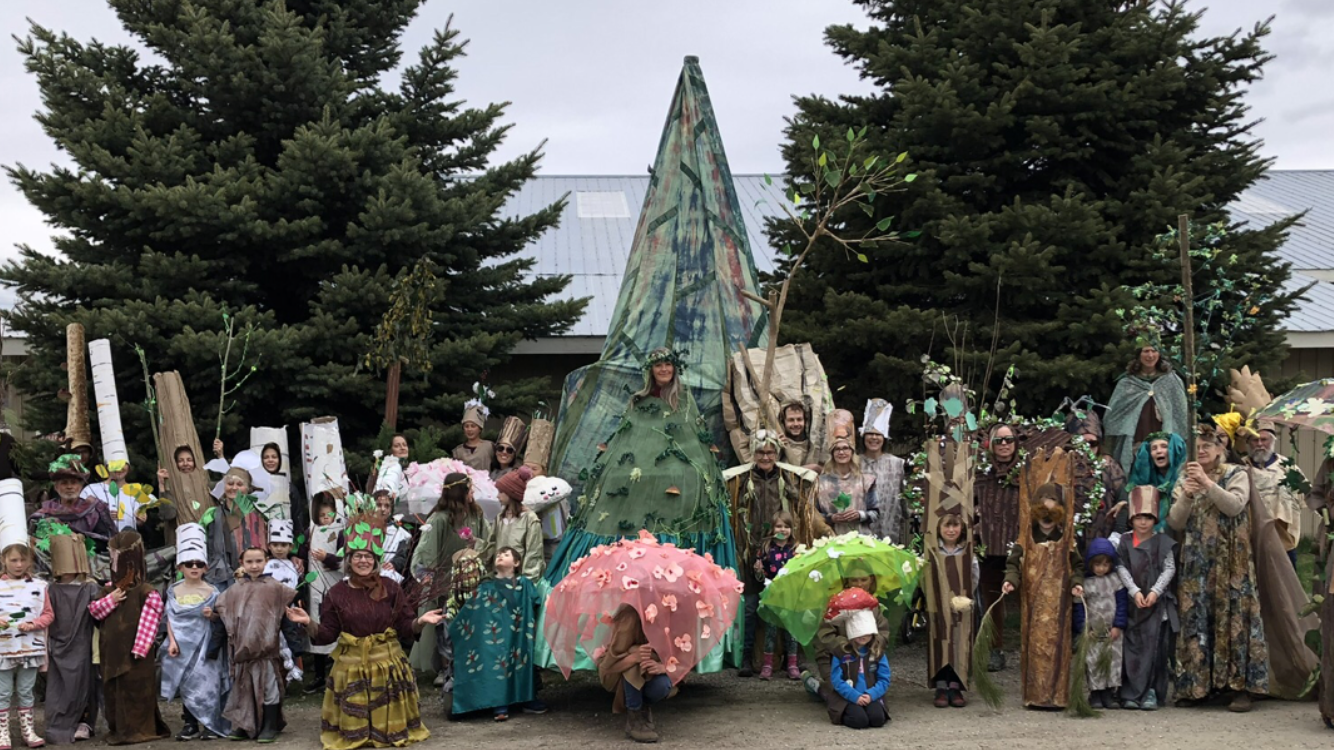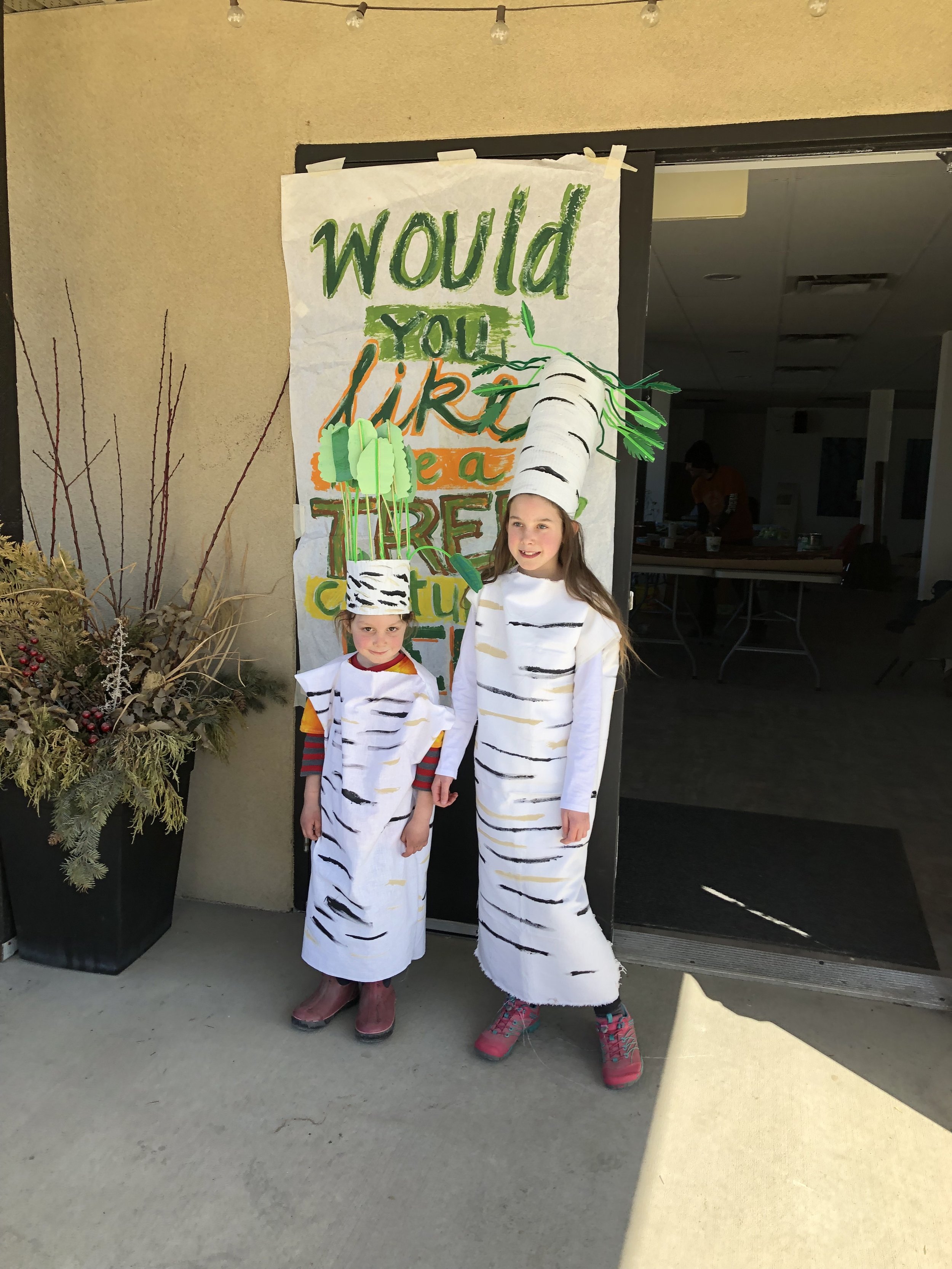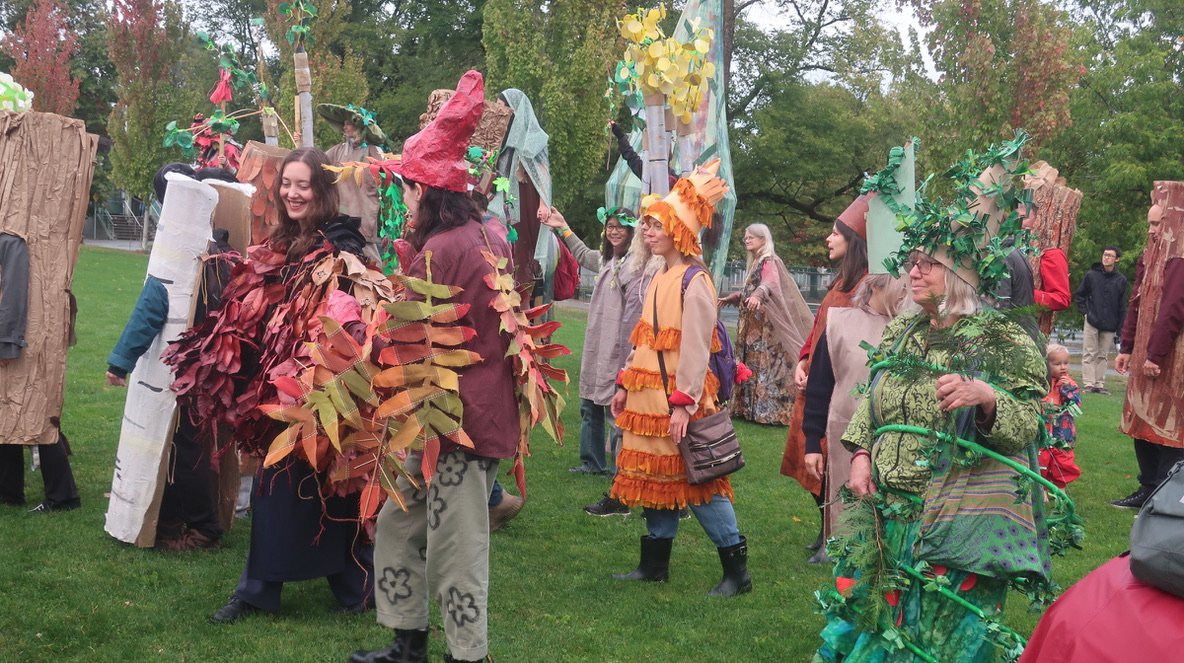
Walk of the Woods
a series of slow quiet parades.
Inspired by a desire to become more familiar with the specific trees that are our neighbours, and the multiple connections that create a forest, we gathered people into a creative exploration of trees.
In each of the many communities we visited, people created costumes, then gathered in very slow moving, poetic parade.
Douglas Fir, Jackpine, Birch, Cottonwood, Larch, hemlock, apple, Ponderosa, Sitka Spruce and more
During the spring and summer of 2023 tree costumes were made in workshops around BC followed by tree parade appearances.
Grindrod : costume creation lab with artists and biologists
Vancouver: Artist Lab
Victoria: 3 workshops; participation in Walk of Old Growth
Enderby: Residency in Shihiya First Nations School, and three classes at MVBeattie, Enderby; Childrens’ Tree Parade
Armstrong: 4 day workshop; Earth Day Parade
Salmon Arm: 4 day workshop; Earth Day Parade
Vancouver: 3 outdoor workshops and 2 parades at UBC
Quesnel: 3 day workshop; Canada Day parade
Mission: 3 day workshop in Mission; parade at Heritage Park
Golden: 3 outdoor workshops; parades at Farmers Market and at outdoor concert
Lumby: 4 day workshop; parade at Seniors Centre
Splatsin: 2 workshops in costuming and stilt walking - Splatsin Band Youth
Enderby Summer camp workshop and mini Parade
Salmon Arm: 2 community workshops and parade at the opening of Salmon Arm Roots and Blues Festival
Vancouver: Workshops and parade at Moberly Community Centre, West Point Grey Community Centre, UBC Farm Market
Slocan Field House: 3 day workshop; Finale with Still Moon Arts at the Ravine Festival
Walk of the Woods took place during the spring and summer of 2023 in communities throughout British Columbia.
Project Artistic Directors: Paula Jardine and Cathy Stubington
Workshop facilitators: Paula Jardine, Cathy Stubington, Deb Humphries, Carolyn Uher, Anne Barber
Guest director: Anne Barber
Assistant facilitators: Natasha Lepine, Kathryn Cooke, Jesse Orr, Rainn Sines, Molly MacGregor, Jasmin Wright, Carolyn Knight,
Stage manager (interior): Dalynn Kearney
Stilt teachers: Renn Bankowski, Isabelle Kirouac, Anne Barber
Guest performers: Willoughby Arevalo, Renn Bankowski, Isabelle Kirouac, Rene Hugo Sanchez, Boris Sichon
Tree Walks: Prof. Warren MacTeague, Aita Bezzola, Barb Dutot, Lorelei
Administration: Jasmin Wright
Partners: M.V.Beattie Elementary School, Shihiya School, Prof. Warren MacTeague dept of Forestry, UBC; Monashee Arts Council (Lumby), Fairfield Community Centre (Victoria), City of Mission Arts and Culture, Salmon Arm Roots and Blues Festival, Still Moon Arts Society, Kicking Horse Culture (Golden), Quesnel Arts Recreation and Culture, Splatsin First Nation Youth
Thanks to:
Alan Duncan Memorial Tree Foundation, Canada Council for the Arts, British Columbia Arts Council, Hamber Foundation, Telus Community Foundation, Government of Canada and the Government of British Columbia


























COMMUNITY PROCESS
We began the project with two “Artist Labs”, to which we invited a group of artists and biologists to get together and create tree costumes. This gave us a varied inventory of costumes to take to parade venues. It was also an opportunity to develop relatively simple templates that we could bring into the schools.
There were several ways in which people could engage with the project:
By going on a tree walk, by creating costumes, by wearing a costume and joining the Walk of the Woods, and by watching the parade!
In each community we visited, we held drop-in workshops, where people could come and spend between one and three days making their own costumes.
On Parade Day, people could wear the costumes they’d made, and we’d have extra costumes for people who decided on-the-spot to join the parade. Afterwards, we’d add the new costumes to our stash, and so we had an evolving collection of trees. We noted that we were gathering trees from different forest ecosystems, as we moved around the Province.
Once people had gathered, Paula led them in a warmup in which they were encouraged to close their eyes and imagine their roots, and trunk, and branches, and to imagine the wind blowing through their leaves or needles. The trees were asked to move as slowly as possible along the path.
Most of the parades were scheduled at a time and place where people were gathering for a purpose - including Earth Day celebrations, markets, concerts. This ensured us an audience, and folk to coax into joining us.
Some of the workshops began with a tree walk, led by a local expert. This allowed us to get to know the trees in the area before starting the making process.
IMPACT
One never knows how an experience affects a person. What we imagine is that participants and viewers will see trees in a new way, especially having made the effort of imagining being a tree. We call this empathetic learning.
We were in Mission twice: in July and again in September. On our return visit, a couple came to talk with us, who’d been in the July workshop and event. The woman wondered if I’d think she’s crazy if she told me that she is now noticing trees all the time, and in an entirely new way. I asked if she particularly identified with Birch? (remembering the tree costume she’d made). “That’s it!” she exclaimed. Her husband said, ”When I’m driving, she’s always saying “STOP! I want to look at that tree!”” and he mimed slamming on the brakes.
We realized that the project had impact even just when we were telling people that we were doing a Tree Parade - for example when we took posters around. People would stop for a moment, and we’d watch their imagination start up… “That’s a good idea!” was always the response.
At our parade at UBC, an audience member said that he felt a deep sense of calm, watching the trees move slowly, slowly through the plants.
Just as we began the parade in Quesnel, the skies opened up with an intense thunderstorm. We walked anyway, and all of the costumes (Including the cardboard ones) were completely soaked. We didn’t mind - the drought was intense.
A Gitxsan woman who’d been talking to us was so excited. “The trees are listening,” she assured us.
Fortunately the Recreation Centre allowed us to lay out all of our stuff overnight in a room, and it was dry by morning.
Tree Appearances
First Walk of the Woods
THURSDAY APRIL 20, ENDERBY
We held our very first (of many) “Walk of the Woods” !
Trees left Shihaya school by bus, and M.V. Beattie on foot, at around 12:30. Did you catch them along the highway!
And at 1PM the two school groups gathered together at the City Hall Parking Lot then gently paraded down Cliff Avenue to Bevedere Park on the River.
Armstrong Earth Day Green Fair
SATURDAY APRIL 22, ARMSTRONG
Walking trees appeared at the ASET Green Fair Earth Day event, at the IPE grounds, just before 11 AM.
Salmon Arm Earth Day Gathering
SATURDAY APRIL 22, SALMON ARM
A grove of trees sauntered down from the Salmon Arm Gallery at 1, to reach the Earth Day gathering at the Ross Street Plaza.
Special Thanks to Anne Barber of Shadowland Theatre for leading our parades in Enderby, Salmon Arm and Armstrong.
Fairfield Community Centre in Victoria
SATURDAY JUNE 3, FAIRFIELD COMMUNITY/VICTORIA
Trees walked through a grove of garry oak trees.
UBC Forest Sciences
SATURDAY JUNE 10, UBC FOREST SCIENCES
Walk of the Woods Quesnel
SATURDAY JULY 1, QUESNEL
The sky opened up and blessed us with a torrent of rain, just as we began the procession.
Astonishingly, the rain only lasted as long as the parade! And the band played on! (They were fabulous).
We were at LeBourdaise Park.
Walk of the Woods Mission
WEDNESDAY JULY 14, MISSION
A lively group of trees with the sounds of the forest provided by Boris Sichon.
Photo credit to Whats On! Mission
Walk of the Woods Golden
WEDNESDAY JULY 26, GOLDEN
Note the blueberry bush in front! New costumes include a wild rose bush, blossoming magnolia tree couture, a long leaf pine, two blue spruces, a birch and 2 new aspens.
What a great community! Our busiest participants were from the Wild Sight Outdoor day camp.
Walk of the Woods Lumby
SATURDAY AUGUST 5, LUMBY
So grateful to the community of Lumby for embracing our tree parade. Many folks came each day to work on their costumes and shared in a lovely parade.
Walk of the Woods in Salmon Arm
FRIDAY AUGUST 18 at the Salmon Arm Roots and Blues Festival
We were led by birds and drums as this tree parade made its way through the festival grounds.
Walk of the Woods at Moberly Community Centre
THURSDAY SEPTEMBER 7th, MOBERLY COMMUNITY CENTRE, VANCOUVER
We held tree costume making workshops for two days and then had a lovely little tree parade.
Walk of the Woods Finale
SATURDAY, SEPTEMBER 23rd, Slocan Park Vancouver, BC
Tree Costume-Making Instructions
Instructions on how to create tree costumes from our Walk of the Woods.
Leafy Headdress and wrist set
What kind of tree would you like to be?
Find a reference, and check out the shape of the leaves or needles and how they’re arranged on the stem.
Here’s an easy-to-make leafy headdress and leafy wrist set.You need:
Stiff cardboard for the base (or fabric)
Stiff paper or card for the leaves
Glue, tape, and/or staples
If front and back need to be different shades, paint, or glue tissue paper to one side of each leaf.
(You could, instead attach two layers of fabric together by sewing or using fusible interfacing).
Glue or tape pipe cleaners to the leaves and then to the headband.
Use fabric or elastic around your wrists.
Simple tunic for tree trunk
What does your tree’s bark look/feel like?
You can make a simple fabric tunic to match it. (Perhaps you can find textured fabric that looks like bark…?).
Measure out a tunic that is the length from your shoulders to your ankles. Ensure you cut out two panels for the front and the back. These two panels can either be sewed together at the shoulders or simply be folded over from one length of fabric.
Cut out a hole for your neck
If front and back panels not connected, sew together along sides and shoulders. Or, even easier, just stitch a tie to front and back.
3 ways to make plain fabric look like bark:
Paint
Stencil:
A: Cut a shape out from cardboard
B: Lay the stencil on the fabric and dab paint over it with a sponge
C: Repeat until covered. Try two colours for texture.
Tie-dye:
You will need cotton fabric and dye.
Tightly twist a length of fabric, let it twist again on itself.
Wrap with string or elastics.
Place the bundle in a bucket of dye then rinse and unwrap
Cardboard costume for tree trunk
Start with a large sheet of cardboard from a box.
To make it bend in a curve, cut lines on one side part way through using a knife and a ruler in the same direction as the corrugation (called scoring).
To texture the surface to be like bark, lay a large piece of brown paper (longer than the cardboard) over the un-cut sided.
Cover an area of the cardboard with glue then scrunch the paper as you lay it in the glue. Press. Keep scrunching until it’s all attached. Scrunch some roots with the extra length of paper.
Cut holes for your eyes and arms.
You can use the white glue mixed with water or follow this recipe for home-made Lovely Glue:
Place one cup of flour + one cup COLD water in a saucepan and whisk until smooth.
Add five cups HOT water (from the tap) then stir constantly as you heat it on the stove.
Make sure you let it cool before using!!!!
Make a mushroom Hat
Make a ring of cardboard to fit your head
Stuff a plastic bag with scrunched-up newspaper.
Stick the bag to the ring using tape. Lots of tape! Use the tape to sculpt the form.
Make Lovely Glue (see above).
Papier Mache- Tear strips of paper and dip them one by one in the glue. Slip off most of the glue with your thumb and finger. Cover the whole form three times. Then give a final layer of white paper
Alternately- newspaper and brown paper bags at the end.
When the mushroom is dry, you can paint it with acrylic paints or you can glue on pieces of coloured tissue paper, using watered down white glue so that it looks like your particular mushroom.
You can make anything this way. Here are two other ideas:
Cone Hat
scrunched paper and tape
papier mache
paper shapes
cover with brown paper and cone scales
Bark Mask:
cardboard ring to fit head
make rolls of newspaper and wrap them with masking tap
tape the rolls to the cardboard ring
papier mache using torn up brown bags… then wear grey-brown clothing.














